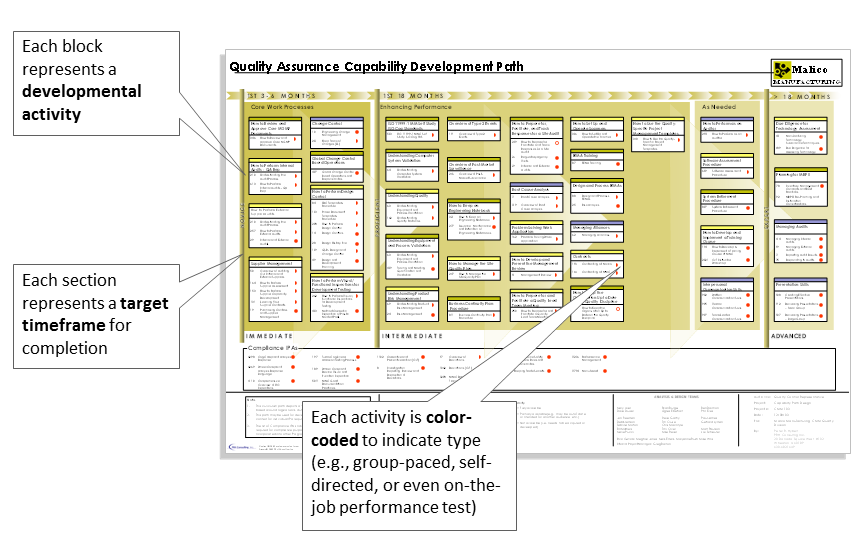Capability Model vs Capability Development Path
Tuesday, 27 September 2011
We have been using a tool we call a “capability model” to display in a “one-pager” format, the key tasks and supporting knowledge, skills, and characteristics needed to perform the tasks…in other words, what the employee needs to be able to do a job or job.
Since it is on one page, it is distilled and some of the details are left out. However, it can provide a simple, useful view of the requirements of the job/role for either a manager or employee. Below is an annotated example of a Capability Model. Please note that the details are not really shown — inside each section are specific items relevant to that role.
It is important to realize that the Capability Model shows the total set of requirements…it does not recommend a sequence for development. Sometimes you can infer development though. Once we created a series of Capability Models for four progressive levels of supervision (from first-line supervisor to plant manager) showing where new tasks and supporting skills were added or increased in importance. You could infer the changes you would need to move from one level to the next which could enable you to infer areas to focus for development. But a better tool for planning development would be a Capability Development Path, which shows developmental activities and key milestones arranged in a logical sequence for development.
Shown below is an annotated graphic of a Capability Development Path. Note that this includes timeframes, though in some cases they are relative and in others more objective.
The development path may contain a combination of development activities, including informal mentor- or self-directed learning, development job assignments, performance-based qualification tests, external certifications, and more standard training events (such as courses).
The intent of the path is to provide a guideline for both employees and managers about what the employee should be doing when in order to progress at a reasonable pace through the role. In many cases, employees want to move up quickly or managers might underestimate all the things the employee needs to master.
Application on the Job
Our role as consultants is more in doing the analysis and design to create these development management tools. However, there are some implementation tips that can help organizations get more benefit from them.
For one thing, keep in mind that every job is unique and every individual is unique. People may come in with some advanced skills while missing some basic skills. It is important to understand the requirements of the individual’s role and then inventory their existing capabilities accordingly to focus their actual development. Maybe instead of a path, it is helpful to think of it as a recommended checklist or menu in some cases.
Align the development system around these tools. Make sure people who are recruiting for new hires are looking for people who will be able to fit into these models. Entry requirements can be deduced (or specified). Specific qualifications can be developed to serve as “gates” for promotions between key levels of the path. Make sure the roles make sense — don’t accumulate capabilities into a single role that are not likely to be found in a single individual. For example, a person with “creative, big picture planning skills” won’t often come with “detail-oriented, organization skills.”

